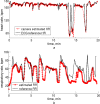Continuous non-contact vital sign monitoring in neonatal intensive care unit
- PMID: 26609384
- PMCID: PMC4612732
- DOI: 10.1049/htl.2014.0077
Continuous non-contact vital sign monitoring in neonatal intensive care unit
Abstract
Current technologies to allow continuous monitoring of vital signs in pre-term infants in the hospital require adhesive electrodes or sensors to be in direct contact with the patient. These can cause stress, pain, and also damage the fragile skin of the infants. It has been established previously that the colour and volume changes in superficial blood vessels during the cardiac cycle can be measured using a digital video camera and ambient light, making it possible to obtain estimates of heart rate or breathing rate. Most of the papers in the literature on non-contact vital sign monitoring report results on adult healthy human volunteers in controlled environments for short periods of time. The authors' current clinical study involves the continuous monitoring of pre-term infants, for at least four consecutive days each, in the high-dependency care area of the Neonatal Intensive Care Unit (NICU) at the John Radcliffe Hospital in Oxford. The authors have further developed their video-based, non-contact monitoring methods to obtain continuous estimates of heart rate, respiratory rate and oxygen saturation for infants nursed in incubators. In this Letter, it is shown that continuous estimates of these three parameters can be computed with an accuracy which is clinically useful. During stable sections with minimal infant motion, the mean absolute error between the camera-derived estimates of heart rate and the reference value derived from the ECG is similar to the mean absolute error between the ECG-derived value and the heart rate value from a pulse oximeter. Continuous non-contact vital sign monitoring in the NICU using ambient light is feasible, and the authors have shown that clinically important events such as a bradycardia accompanied by a major desaturation can be identified with their algorithms for processing the video signal.
Keywords: ECG-derived value; NICU; O2; adhesive electrodes; adhesive sensors; adult healthy human volunteers; ambient light; biochemistry; biomedical equipment; biomedical optical imaging; blood vessels; bradycardia identification; breathing rate estimation; camera-derived estimates; cardiac cycle; cardiology; clinical letter; continuous heart rate estimation; continuous noncontact vital sign monitoring; continuous oxygen saturation estimation; continuous pre-term infant monitoring; continuous respiratory rate estimation; continuous vital sign monitoring technologies; digital video camera; direct patient contact; electrocardiogram; estimation theory; feature extraction; high-dependency care area; hospital; incubators; infant nursing; infant pain; infant skin damage; infant stress; major desaturation; mean absolute error; medical image processing; minimal infant motion; neonatal intensive care unit; oximetry; oxygen; paediatrics; patient care; patient monitoring; pneumodynamics; pulse oximeter; reference heart rate value; stable sections; superficial blood vessel colour change measurement; superficial blood vessel volume change measurement; time 4 day; video cameras; video recording; video signal processing algorithms; video-based noncontact monitoring methods.
Figures






References
-
- McIntosh N.: ‘The monitoring of critically ill neonates’, J. Med. Eng. Technol., 1983, 7, (3), pp. 121–129 (doi: ) - PubMed
-
- Scalise L., Bernacchia N., Ercoli I., Marchionni P.: ‘Heart rate measurement in neonatal patients using a webcamera’. IEEE Int. Symp. on Medical Measurements and Applications Proc., 2012, pp. 1–4
-
- Aarts L.A., Jeanne V., Cleary J.P., et al. : ‘Non-contact heart rate monitoring utilizing camera photoplethysmography in the neonatal intensive care unit – a pilot study’, Early Hum. Dev., 2013, 89, (12), pp. 943–948 (doi: ) - PubMed
-
- Klaessens J.H.G.M., van den Born M., van der Veen A.J., et al. : ‘Development of a baby friendly non-contact method for measuring vital signs: first results of clinical measurements in an open incubator at a neonatal intensive care unit’. Proc. of SPIE, 2014, vol. 8935, pp. 1–7
-
- Wu H.Y., Rubinstein M., Shih E., Guttag J., Durand F., Freeman W.: ‘Eulerian video magnification for revealing subtle changes in the world’, ACM Trans. Graph., 2012, 31, (4), p. 65 (doi: )
LinkOut - more resources
Full Text Sources
Other Literature Sources

